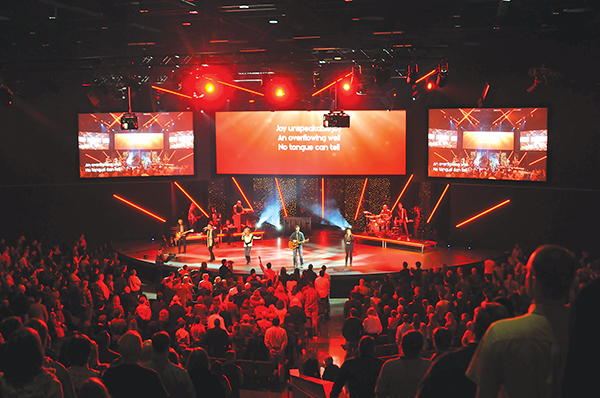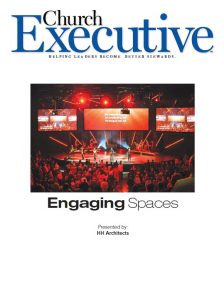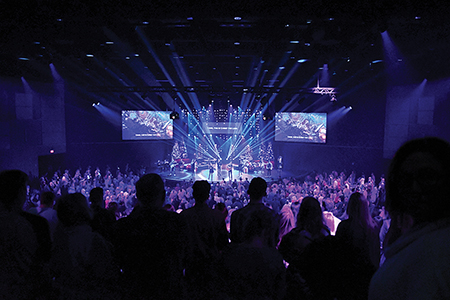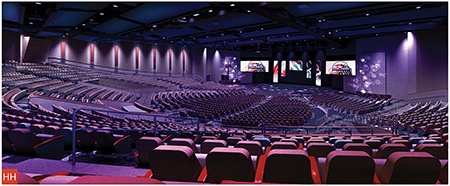
By Mark R Ashcraft with Bruce Woody, AIA
The act of worship is a very personal experience. No matter the style of worship, there are common elements that will create an engaging experience.
A sanctuary — or worship center, depending on your tradition — is a big factor in the act of worship itself. A well-designed space will help create the atmosphere for receiving the message, as well as provide visual clues on expectations.

What really defines an engaging space for worship? There are several characteristics which create connection, both horizontal and vertical; however, we will look at four: room shaping, focal points, finish selection and technology.
Room shaping & focal points
The architecture of the room itself has a profound impact on the user experience.
Acoustically, can the audience clearly hear the speaker, as well as participate in the worship?
Visually, think about the focal points within the room. At Church of the Incarnation in University Park, Texas, gothic-inspired architecture provides visual clues to the liturgical elements of the worship setting. A traditional straight nave and transept indicate the formality of the layout, and the detailed chancel area with the altar and baldaquin provide a focal point for parishioners.
The layout of seating in a room will drive both the personal and corporate experience. Is it presentational or communal? To create community, people need to hear and see each other during worship.
 Cornerstone Chapel in Leesburg, Va. (above), uses terrace seating wrapping around the lower bowl to create a more intimate experience in a large-room setting.
Cornerstone Chapel in Leesburg, Va. (above), uses terrace seating wrapping around the lower bowl to create a more intimate experience in a large-room setting.
Architectural elements can be used to draw in people by the leading the eye to area of importance. The teaching & worship style at Northwood Church in Keller, Texas, is driven by a strong sense of community. To reinforce this tradition, stepped seating from the platform to the top terrace wraps around a large thrust stage to create a space where everyone is visually connected.
Elements like a cross or baptistery are visual clues to what transpires, but can also be used as

features to provide interest, as long as they do not distract from the worship setting.
Finish selection
It is the touch and feel of the space. We are sensory creatures full of emotion that is shaped and influenced by our surroundings. We are seeking a welcoming environment where we can settle the mind and be open to worship. Creating a sense of retreat — a place to renew — increases the comfort and helps bring down barriers.

Cornerstone Chapel uses natural materials and neutral tones to define a retreat feel and large glass walls in its worship center to allow views out, recalling its retreat setting and design.
A worship space should also speak the same language in terms of finishes as the architectural design and worship style. The use of stone buttresses, cast stone tracery and timber trusses at the Church of the Incarnation all reinforce the rich tradition of the liturgy — creating a congruent message.
Another consideration in the feel of the space is seats versus pews. Pews tend to suggest a more traditional approach, while seats are more modern. It is a subtle visual clue that drives expectations.

Technology
The level of technology is typically theologically driven, but it is becoming more relevant in modern worship settings. Being able to tune the room digitally for different atmospheres, echoing and visually supporting both the worship and teaching aspects of a service, is a key driver of an engaging experience. The visual environment created should engage, but not become a deterrent to worship.
A highly creative and energetic church, Preston Trail Community Church in Frisco, Texas, wanted a worship space which was a neutral canvas the church could “paint” with lighting and technology. Being able to use various lighting setups and screen technology gives them the ability to create a multitude of environments to enhance and support the worship experience.
First Baptist Covington in St. Tammany Parish, La., desired a flexible platform allowing for both choral and praise band-led worship. LED screens across the front are designed to allow for not only supporting text, but graphics and texture, as well. Lighting along the side walls, along ceiling planes, and the main house lighting is all RGB LED and can be controlled or tuned independently, allowing great flexibility in designing the worship experience.

Parting thoughts
In Psalms 95:6, we read Oh come, let us worship and bow down; let us kneel before the LORD, our Maker! Next time you walk into a sanctuary (worship center), take a moment to reflect on what the space says to you.
Does it help in creating the right atmosphere for receiving the message, or encouraging participation in worship?
We can enhance our engagement by using lighting, finishes and the architectural design to give visual interest to the space and inspire a sense of wonder and excitement for what is to come!
Mark R Ashcraft is a senior associate of HH Architects in Richardson, Texas. He serves as the Creative Director for the firm and has been blessed to work with many ministries during his 17-year tenure.
Bruce Woody, AIA, is the president & CEO of HH Architects. He speaks around the country on the importance of campus master planning and has been working with ministries for more than 30 years.


